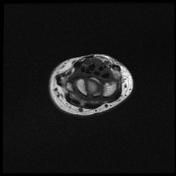83 results found
Case
Carpal tunnel syndrome (MRI)

Published
20 Feb 2013
71% complete
MRI
Case
Carpal tunnel syndrome - with inverted notch sign

Published
07 Dec 2017
79% complete
Ultrasound
Case
Carpal tunnel syndrome and De Quervain tenosynovitis

Published
30 Jul 2019
80% complete
MRI
Case
Carpal tunnel syndrome (MRI)

Published
26 Sep 2018
71% complete
MRI
Case
Carpal tunnel syndrome in bifid median nerve

Published
26 Feb 2013
79% complete
Ultrasound
Case
Carpal tunnel syndrome

Published
16 Jan 2010
63% complete
Ultrasound
Case
Carpal tunnel syndrome - with inverted notch sign

Published
16 Jun 2014
75% complete
Ultrasound
Playlist
Carpal tunnel syndrome

1 case
No description provided
Playlist
carpal tunnel syndrome




13 cases
No description provided
Article
Pronator teres syndrome
Pronator teres syndrome (also called pronator syndrome) is one of three common median nerve entrapment syndromes; the other two being anterior interosseous nerve syndrome and the far more common carpal tunnel syndrome. Signs and symptoms result from compression of the median nerve in the upper f...
Article
Nerve compression syndrome
Nerve compression syndromes or nerve entrapment neuropathies are a group of several nerve disorders associated with sensory and/or motor loss resulting from nerve compression.
Epidemiology
Nerve compression syndromes are common 1-5 and can account for 10-20% of cases in specialist clinics of n...
Article
Median nerve flattening ratio
The median nerve flattening ratio is a parameter used for the diagnosis of carpal tunnel syndrome (usually by ultrasound). It is calculated by dividing the span of the long axis by that of the short axis of the median nerve at around the pisiform level.
A ratio of greater then 3 is often consi...
Article
Tarsal tunnel syndrome
Tarsal tunnel syndrome refers to an entrapment neuropathy (tunnel syndrome) of the (posterior) tibial nerve or of its branches within the tarsal tunnel. This condition is analogous to carpal tunnel syndrome.
Clinical presentation
The most common symptoms are pain and paresthesia in the toes, s...
Article
MRI of the wrist (an approach)
MRI of the wrist is a fairly frequent examination in musculoskeletal radiology practice and not quite as common in general radiological practice. This approach is an example of how to create a radiological report of an MRI of the wrist with coverage of the most common anatomical sites of possibl...
Article
Anterior interosseous nerve syndrome
Anterior interosseous nerve syndrome (AINS), also known as Kiloh-Nevin syndrome, is one of three common median nerve entrapment syndromes, the other two being pronator teres syndrome and the far more common carpal tunnel syndrome.
Epidemiology
Anterior interosseous nerve syndrome is a rare ent...
Question
Question 1656
75 years old man with fatigue, dyspnea on exertion and a history of bilateral carpal tunnel syndrome.
RTA reported difficulties obtaining a good inversion time in this patient. The width of the interventricular septum measured 20 mm. T1 was in the range of 1170-1250 ms that is >6 standard deviations above the normal range. Myocardial extracellular cellular volume (ECV) >55%.
What is the most likely diagnosis?
Article
Lunate dislocation
Lunate dislocations are an uncommon traumatic wrist injury that require prompt management and surgical repair. The lunate is displaced and rotated volarly. The rest of the carpal bones are in a normal anatomic position in relation to the radius.
These should not be confused with perilunate disl...
Article
Acroparesthesia
Acroparesthesia refers to tingling, pins-and-needles, burning or numbness or stiffness in the hands and feet, particularly the fingers and toes 1. Occasionally episodic pain is also present, which can be very severe 1.
It is one of the more common manifestations of Fabry disease (more common t...
Article
Acromegaly
Acromegaly is the result of excessive growth hormone production in skeletally mature patients, most commonly from a pituitary adenoma. The same excess of growth hormone in individuals whose epiphyses have not fused will result in gigantism (excessively tall stature).
Epidemiology
Acromegaly ...
Article
Dorsal bridge plate fixation
Dorsal bridge plate fixation is an open reduction internal fixation technique for extensive comminuted articular and metaphyseal radial fractures.
Terminology
Dorsal bridge plate fixation is also known as dorsal spanning plate fixation.
Indications
The main indication is the treatment of dif...









 Unable to process the form. Check for errors and try again.
Unable to process the form. Check for errors and try again.